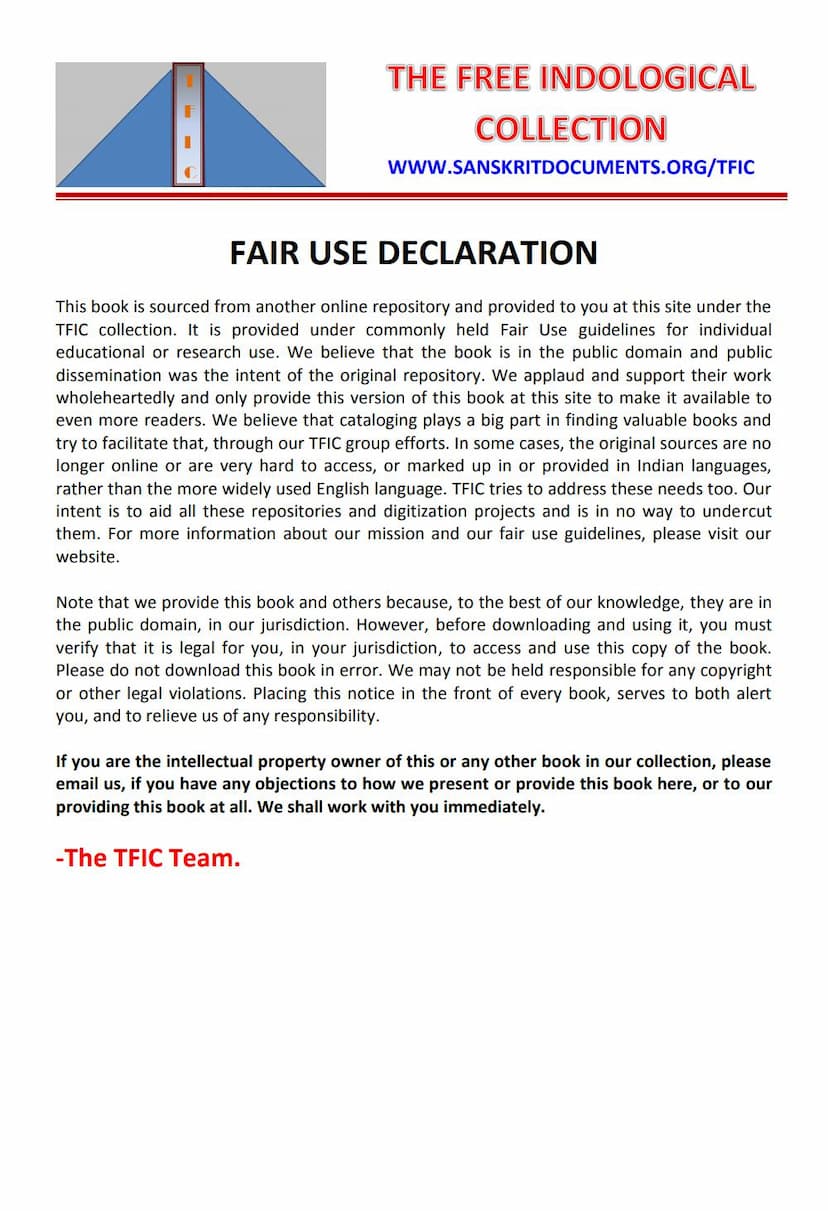Tattva Kaumudi
Added to library: September 2, 2025

Summary
The Tattva-Kaumudi, authored by Vācaspati Miśra and published by Oriental Book Agency Poona, is a seminal Jain text that offers a comprehensive exposition of Sāmkhya philosophy. The text is divided into seventy Kārikās (verses), each delving into various aspects of Sāmkhya metaphysics, epistemology, and cosmology.
Introduction and Core Doctrines:
The Tattva-Kaumudi begins by establishing the philosophical inquiry's origin in the universal human desire for happiness and aversion to pain. It asserts that true happiness, unlike fleeting sense pleasures, is absolute and eternal, achievable through philosophical understanding. The text emphasizes the antiquity and significance of Sāmkhya philosophy, highlighting its influence and discussion within various Indian philosophical schools.
Epistemology (Pramāņas):
The Tattva-Kaumudi meticulously outlines the three primary means of valid cognition (Pramāņas):
- Perception (Pratyakṣa): Defined as the definite cognition of particular objects through the contact of the senses. It emphasizes that perception is direct and specific to particular objects.
- Inference (Anumāna): Described as a three-fold process:
- Purvavat (A Priori): Inferring the cause from the effect.
- Seṣavat (A Posteriori): Inferring the effect from the cause.
- Samanyato-dṛṣṭa (Based on General Observation): Inferring imperceptible things from their perceptible effects, or inferring general principles from specific observations.
- Valid Assertion (Āptavacana / Śabda): This refers to reliable testimony, primarily from authoritative sources like the Vedas, Smṛtis, and Itihāsas, which are considered self-valid.
The text also critically examines and refutes other epistemological categories like Analogy (Upamāna), Presumption (Arthāpatti), Absence (Abhāva), and Rumour (Aitihya), demonstrating their inclusion within the primary three.
Metaphysics and Cosmology (Tattvas):
The Tattva-Kaumudi presents the Sāmkhya theory of twenty-four tattvas (principles) that evolve from Primordial Matter (Prakṛti). Prakṛti, the uncaused and unmanifest source, is characterized by its three Gunas:
- Sattva: Associated with illumination, happiness, and lightness.
- Rajas: Associated with activity, pain, and motion.
- Tamas: Associated with inertia, delusion, and darkness.
The Tattva-Kaumudi details the evolutionary process:
- Prakṛti (Primordial Matter): The unmanifest, uncaused, and eternal source.
- Mahat (Buddhi / Intellect): The first evolute of Prakṛti, responsible for determination and ascertainment.
- Ahaṁkāra (Ego-principle): Evolves from Buddhi, responsible for self-consciousness and the notion of 'I'.
- Eleven Sense-organs: Five sensory organs (eye, ear, nose, tongue, skin) and five motor organs (speech, hand, feet, excretory organ, generative organ), along with Manas (mind), which acts as an observer and coordinator.
- Five Rudimentary Elements (Tanmātras): Subtle elements of sound, touch, colour, taste, and odour.
- Five Gross Elements: Earth, Water, Fire, Air, and Ether, which evolve from the respective Rudimentary Elements.
The text further explains the nature of the subtle body (Linga Sarira), its migration through different physical bodies, and its role in the transmigration of the soul.
The Spirit (Puruṣa):
A significant portion of the Tattva-Kaumudi is dedicated to establishing the existence, nature, and plurality of the Spirit (Puruṣa). The Spirit is described as:
- Pure Consciousness: The source of intelligence and sentience.
- Inactive and Unchanging: It is the witness, not the doer.
- Without Attributes: Devoid of the three Gunas.
- Multiple: Each individual possesses a distinct Spirit.
The text elucidates how the Spirit, though essentially pure and unattached, appears to experience pleasure and pain due to its association with Buddhi and the Gunas of Prakṛti.
Bondage and Liberation (Kaivalya):
The Tattva-Kaumudi explains bondage as the Spirit's mistaken identification with the modifications of Prakṛti due to ignorance (Avidyā). Liberation (Kaivalya) is achieved through discriminative knowledge – the direct apprehension of the Spirit's distinctness from Prakṛti and its Gunas. This liberation is described as the cessation of all forms of suffering and the return of the Spirit to its pure, isolated state.
Critique of Other Systems:
The text implicitly and explicitly critiques other philosophical systems, such as the Bauddha (Idealism), Nyāya, and Vedānta, by demonstrating how the Sāmkhya principles offer a more coherent and complete explanation of reality.
Overall Significance:
The Tattva-Kaumudi serves as a foundational text for understanding Sāmkhya philosophy, offering a systematic and detailed account of its core tenets. It provides a clear framework for comprehending the Sāmkhya worldview, from the nature of reality and the means of knowledge to the process of evolution and the ultimate goal of liberation. The Kārikās, along with Vācaspati Miśra's commentary, offer deep insights into the intricate philosophical arguments and reasoning of this ancient Indian school of thought.